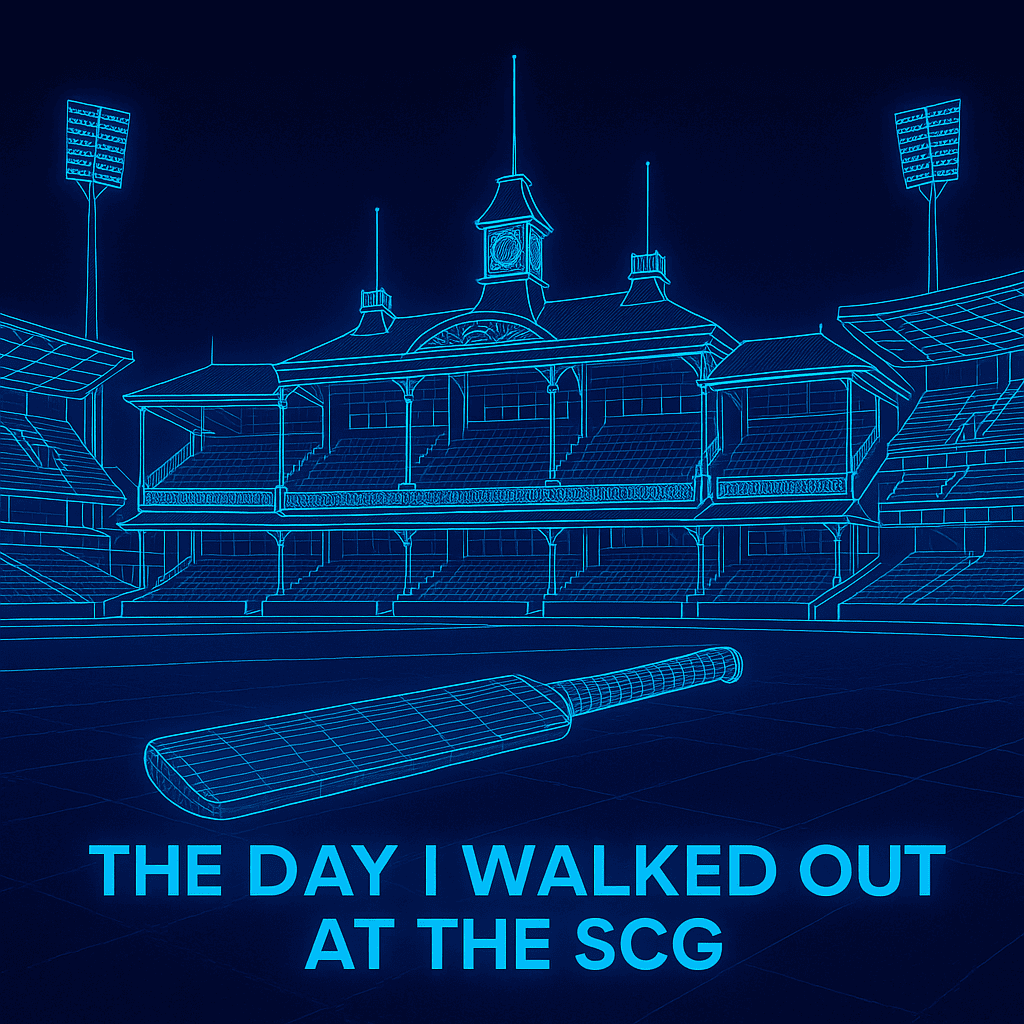
The Day I Walked Out at the SCG
BlogI still remember the nerves hitting me as I sat in the dressing room of the historic Members Pavilion at the Sydney Cricket Ground.
My palms were sweaty, heartbeat thumping, the soft thud of my own footsteps echoing off timber that had absorbed more cricketing history than any museum wall ever could.
This was the room — the place where titans of the game had sat before walking out to face their moment.
Bradman. Botham. Warne. Border. Waugh.
Names that carry their own gravitational force.
I stood, walked down the narrow steps, pushed open the old wooden door, walked down the steps, past the members, and stepped out onto the sacred SCG turf — the same turf where thousands roar, careers are made, and legends are written.
And as my shoes sank slightly into that perfectly manicured grass, one thing hit me:
I wasn’t here to play cricket.
I wasn’t here to bowl the first ball, hit the winning runs, or take a screamer at slip.
I was here…
to capture 112,000 stadium assets.
Not quite the sporting debut most people imagine — but honestly?
Just as important for the future of the SCG.
Cricket and Asset Management Have a Lot More in Common Than You’d Think
In cricket, success comes down to moments that most people never notice:
the shine on the ball, the subtle field placement, the conditions of the pitch.
In asset management?
It’s the same story — the small things decide the big outcomes.
A rusting bracket no one checks.
A pump running 10 years past its intended life.
A system buried in a spreadsheet no one has opened since 2016.
At the SCG, that challenge was magnified. The venue is effectively a small city:
mechanical systems, seating infrastructure, food outlets, lifts, lighting, signage, pumps, fans, switchboards… the list goes on.
And yet, the SCG team faced the same issue that almost every organisation eventually confronts:
No single source of truth.
Data was outdated.
Some assets were missing entirely.
Maintenance planning relied on “best guess.”
And capital forecasting required more luck than strategy.
The similarities with a cricket team relying on guesswork instead of analytics were… obvious.
Walking Out to Bat: The SCG Asset Capture Project
Now, unlike Test cricket, this wasn’t going to take five days.
But it wasn’t going to take five weeks.
Using Ai Assets’ intelligent capture system, we ran the entire project with one technician over two weeks, capturing:
- 112,000+ assets
- Every asset with make, model, serial, and condition
- All barcoded and photographed.
- 2,000+ defects identified
- 100+ health & safety issues flagged in real time
- A live, centralised asset register ready for maintenance, insurance, compliance and lifecycle planning
- A full 20-year lifecycle profile ready for robust planning
And just like that, the SCG had something it never had before:
Clarity.
Not just about what assets existed — but what condition they were in, what risks they presented, and what the next decade of maintenance and CapEx should look like.
The SCG’s ROI: Bigger Than a Boxing Day Crowd
Let’s talk results — because in sport and asset management, the scoreboard matters.
Initial Capture Savings
- Traditional consultants: $72,000
- Ai Assets: $20,000
- Immediate saving: $52,000
The ongoing ROI was even better:
- $500,000+ saved in reactive maintenance
- $200,000+ in CapEx optimisation
- $75,000+ in annual energy improvements
- $150,000+ in avoided H&S risk exposure
- $25,000+ per year saved in admin and compliance support
Total estimated ROI?
More than $912,000 — and that’s just Year 1.
Not bad for a project that took the less time than ball 1 being bowled in the 1st Ashes test, to the final ball of the 2nd test.
So… Why Talk Cricket?
Because cricket teaches us something crucial:
You can’t win without data.
Batting averages, wagon wheels, ball-tracking, swing metrics — the sport is built on insights, patterns, and decisions backed by evidence.
Facilities are no different.
If you don’t know:
- what assets you have
- where they are
- what condition they’re in
- what risks they present
- how long they’ll last
… then you’re effectively sending your team into an Ashes Test blindfolded.
Accurate data isn’t a luxury.
It’s not “nice to have.”
It’s the difference between predictable performance and total chaos.
And when you’re operating a major venue, a hospital, a retail centre, a warehouse portfolio, or aged-care community?
You want to feel like Steve Waugh walking out at the SCG — confident, prepared, and in control.
Not like a nervous bloke clutching a tablet in the Members Pavilion.
Final Thoughts — And a Good Luck Message
As Australia and England walk out for the first ball of the Ashes in Perth this Friday, I’ll be smiling — because I’ll remember my own “day one.”
Not as a player.
Not as a coach.
But as someone who got to walk out onto one of the world’s most iconic grounds and help deliver clarity, efficiency, and real financial impact.
And if there’s one thing both cricket and asset management can agree on, it’s this:
You can’t manage what you can’t measure — and you can’t win without great data.
Here’s to a brilliant Ashes Test series…
And here’s to every organisation making smarter, data-driven decisions with accurate, centralised, living asset information.




